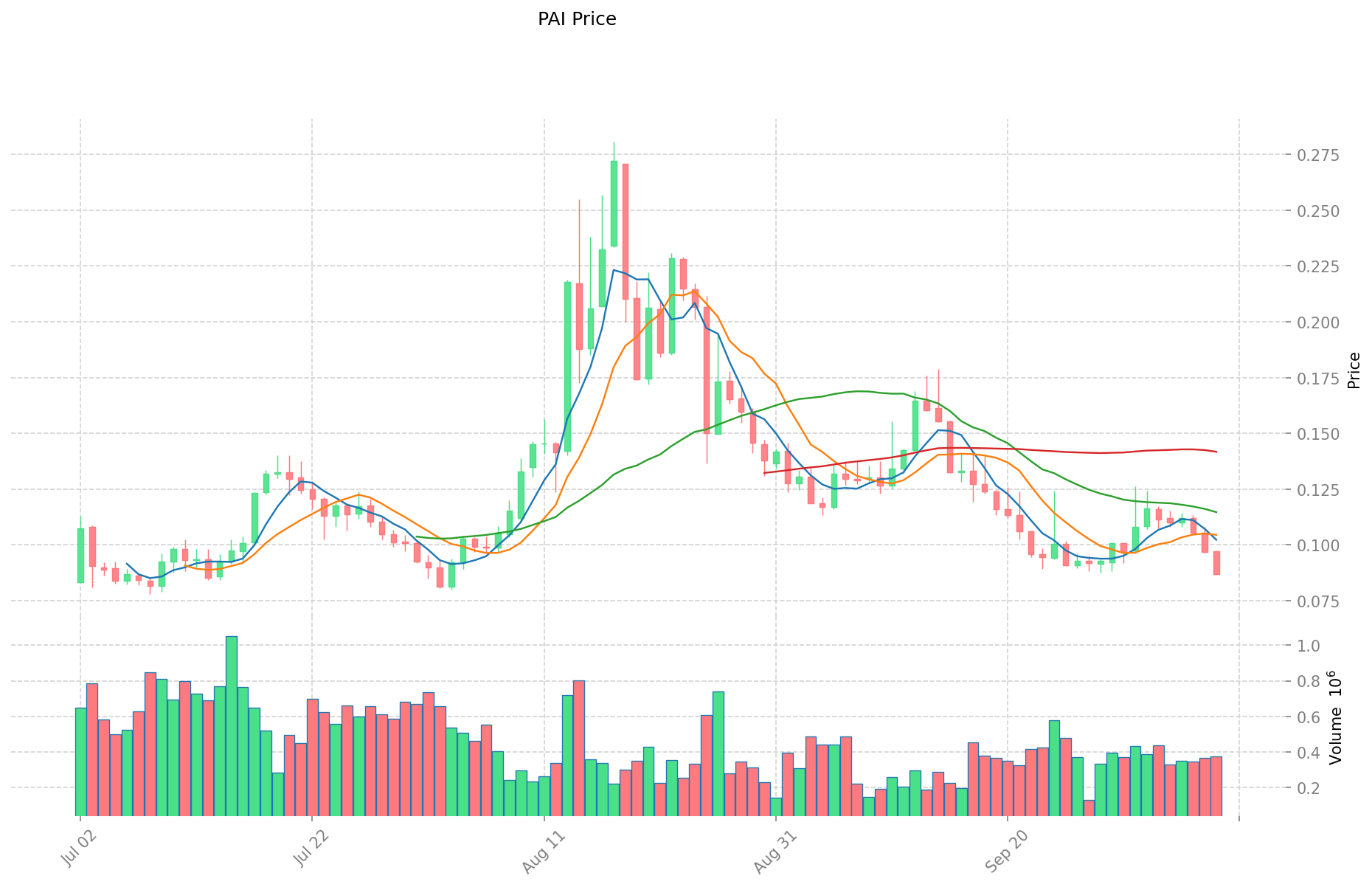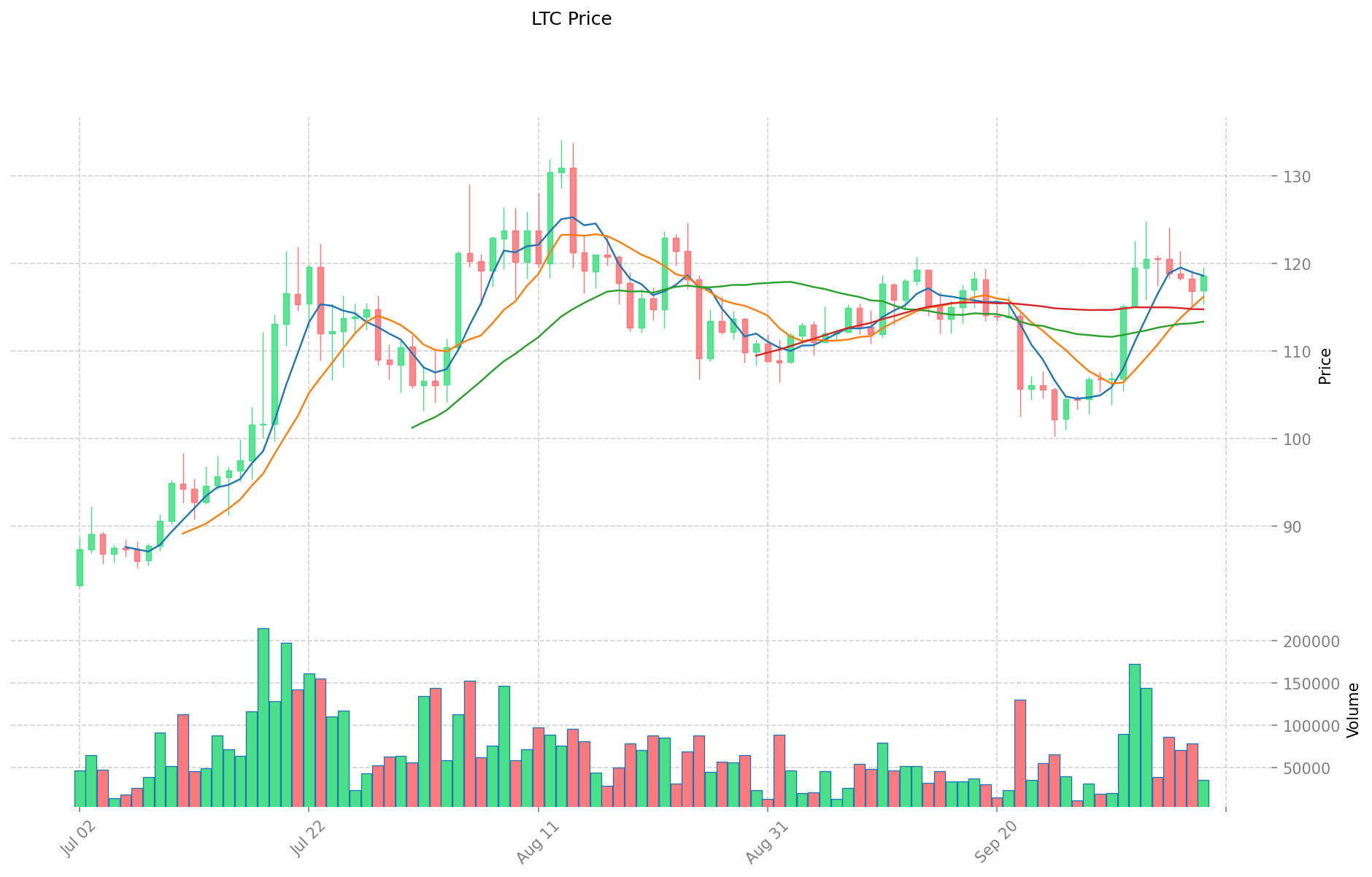PAI vs LTC: Comparing Pathfinder AI's Innovative Approach with Long-Term Care Traditional Methods
Introduction: Investment Comparison between PAI and LTC
In the cryptocurrency market, the comparison between ParallelAI (PAI) and Litecoin (LTC) remains a topic of interest for investors. The two coins differ significantly in market cap ranking, use cases, and price performance, representing distinct positions in the crypto asset landscape.
ParallelAI (PAI): Launched in 2024, PAI has gained market recognition for its innovative approach to AI development and GPU optimization.
Litecoin (LTC): Introduced in 2011, LTC has been dubbed the "silver to Bitcoin's gold" and is one of the most widely traded cryptocurrencies globally.
This article will provide a comprehensive analysis of PAI vs LTC's investment value, focusing on historical price trends, supply mechanisms, institutional adoption, technological ecosystems, and future projections, aiming to answer the question most crucial to investors:
"Which is the better buy right now?"
I. Price History Comparison and Current Market Status
ParallelAI (PAI) and Litecoin (LTC) Historical Price Trends
- 2024: PAI reached its all-time high of $1.518 due to increased adoption in AI computing.
- 2021: LTC hit its all-time high of $410.26 during the overall crypto market bull run.
- Comparative analysis: In recent market cycles, PAI dropped from its high of $1.518 to a low of $0.03475, while LTC demonstrated more stability, maintaining a price above $100.
Current Market Situation (2025-10-09)
- PAI current price: $0.087
- LTC current price: $119.02
- 24-hour trading volume: PAI $34,202.52 vs LTC $4,261,917.11
- Market Sentiment Index (Fear & Greed Index): 70 (Greed)
Click to view real-time prices:
- View PAI current price Market Price
- View LTC current price Market Price


Factors Influencing PAI vs LTC Investment Value
Supply Mechanisms Comparison (Tokenomics)
- PAI: Functions as a decentralized network economy regulated through supply and demand relationships
- LTC: Has a maximum supply of 73 million coins with halving mechanism (reduced to 6.25 LTC per block after August 2023)
- 📌 Historical Pattern: LTC's halving cycles have historically preceded price movements, similar to Bitcoin's pattern but with different timing
Institutional Adoption and Market Applications
- Institutional Holdings: LTC has gained renewed interest from investors due to its technical stability and payment functionality
- Enterprise Adoption: LTC shows stronger adoption in payment systems, positioning itself as a "crypto payment pioneer" rather than just "digital silver"
- Regulatory Attitudes: LTC benefits from longer market presence and established regulatory framework, creating more certainty for institutional investors
Technical Development and Ecosystem Building
- PAI Technical Features: Focuses on building a decentralized economic system through market adjustment mechanisms
- LTC Technical Development: Originally created to solve Bitcoin's slow transaction confirmation and high fees, maintaining technical stability as core advantage
- Ecosystem Comparison: LTC has more established payment infrastructure and exchange listings, with significant market presence (though only 1/5 of Bitcoin's holder addresses, 1/90 of market share, and 1/26 of price)
Macroeconomic Factors and Market Cycles
- Performance During Inflation: LTC has demonstrated historical resilience during various market conditions
- Monetary Policy Impact: LTC price movements show correlation with broader crypto market cycles, having risen approximately 140% from 2024 lows
- Geopolitical Factors: LTC's established status as "payment-type crypto asset" provides utility value beyond speculative investment
III. 2025-2030 Price Prediction: PAI vs LTC
Short-term Prediction (2025)
- PAI: Conservative $0.0441966 - $0.08666 | Optimistic $0.08666 - $0.0944594
- LTC: Conservative $96.0336 - $118.56 | Optimistic $118.56 - $122.1168
Mid-term Prediction (2027)
- PAI may enter a growth phase, with an estimated price range of $0.07329902118 - $0.14040375888
- LTC may enter a steady growth phase, with an estimated price range of $65.39188656 - $134.55638196
- Key drivers: Institutional capital inflow, ETF, ecosystem development
Long-term Prediction (2030)
- PAI: Base scenario $0.104209503348646 - $0.144735421317564 | Optimistic scenario $0.144735421317564 - $0.173682505581076
- LTC: Base scenario $137.28925634547123 - $176.0118671095785 | Optimistic scenario $176.0118671095785 - $251.696969966697255
Disclaimer
PAI:
| 年份 | 预测最高价 | 预测平均价格 | 预测最低价 | 涨跌幅 |
|---|---|---|---|---|
| 2025 | 0.0944594 | 0.08666 | 0.0441966 | 0 |
| 2026 | 0.115916416 | 0.0905597 | 0.070636566 | 4 |
| 2027 | 0.14040375888 | 0.103238058 | 0.07329902118 | 18 |
| 2028 | 0.1437486719592 | 0.12182090844 | 0.0755289632328 | 40 |
| 2029 | 0.156686052435528 | 0.1327847901996 | 0.127473398591616 | 52 |
| 2030 | 0.173682505581076 | 0.144735421317564 | 0.104209503348646 | 66 |
LTC:
| 年份 | 预测最高价 | 预测平均价格 | 预测最低价 | 涨跌幅 |
|---|---|---|---|---|
| 2025 | 122.1168 | 118.56 | 96.0336 | 0 |
| 2026 | 131.168856 | 120.3384 | 108.30456 | 1 |
| 2027 | 134.55638196 | 125.753628 | 65.39188656 | 5 |
| 2028 | 154.8844559262 | 130.15500498 | 93.7116035856 | 9 |
| 2029 | 209.504003766057 | 142.5197304531 | 94.063022099046 | 20 |
| 2030 | 251.696969966697255 | 176.0118671095785 | 137.28925634547123 | 48 |
IV. Investment Strategy Comparison: PAI vs LTC
Long-term vs Short-term Investment Strategies
- PAI: Suitable for investors focusing on AI computing potential and ecosystem growth
- LTC: Suitable for investors seeking stability and payment functionality
Risk Management and Asset Allocation
- Conservative investors: PAI: 10% vs LTC: 90%
- Aggressive investors: PAI: 30% vs LTC: 70%
- Hedging tools: Stablecoin allocation, options, cross-currency portfolio
V. Potential Risk Comparison
Market Risk
- PAI: Higher volatility due to newer market status
- LTC: Susceptible to overall crypto market trends
Technical Risk
- PAI: Scalability, network stability
- LTC: Mining centralization, potential security vulnerabilities
Regulatory Risk
- Global regulatory policies may have different impacts on both assets
VI. Conclusion: Which Is the Better Buy?
📌 Investment Value Summary:
- PAI advantages: Innovative AI computing focus, potential for ecosystem growth
- LTC advantages: Established payment network, historical stability, halving mechanism
✅ Investment Advice:
- New investors: Consider a higher allocation to LTC for stability
- Experienced investors: Balanced portfolio with both PAI and LTC
- Institutional investors: LTC may be preferred due to established market presence and regulatory clarity
⚠️ Risk Warning: Cryptocurrency markets are highly volatile. This article does not constitute investment advice. None
VII. FAQ
Q1: What are the main differences between PAI and LTC? A: PAI is a newer cryptocurrency focused on AI computing and GPU optimization, launched in 2024. LTC, introduced in 2011, is an established cryptocurrency known for its payment functionality and stability. PAI has higher volatility and growth potential, while LTC offers more stability and wider adoption in payment systems.
Q2: Which coin has performed better in terms of price history? A: LTC has demonstrated more price stability, maintaining a price above $100 in recent market cycles. PAI, being newer, has shown higher volatility, dropping from its all-time high of $1.518 to a low of $0.03475. LTC reached its all-time high of $410.26 in 2021 during the overall crypto market bull run.
Q3: How do the supply mechanisms of PAI and LTC differ? A: PAI functions as a decentralized network economy regulated through supply and demand relationships. LTC has a maximum supply of 73 million coins with a halving mechanism, which reduced block rewards to 6.25 LTC after August 2023.
Q4: Which coin is more suitable for institutional investors? A: LTC is generally more suitable for institutional investors due to its longer market presence, established regulatory framework, and stronger adoption in payment systems. It provides more certainty and stability compared to the newer PAI.
Q5: What are the price predictions for PAI and LTC by 2030? A: For PAI, the base scenario predicts a range of $0.104209503348646 - $0.144735421317564, with an optimistic scenario of $0.144735421317564 - $0.173682505581076. For LTC, the base scenario predicts a range of $137.28925634547123 - $176.0118671095785, with an optimistic scenario of $176.0118671095785 - $251.696969966697255.
Q6: How should investors allocate their portfolio between PAI and LTC? A: Conservative investors might consider allocating 10% to PAI and 90% to LTC, while more aggressive investors could opt for 30% PAI and 70% LTC. New investors may want to lean towards a higher allocation in LTC for stability, while experienced investors might balance their portfolio with both coins.
Q7: What are the main risks associated with investing in PAI and LTC? A: PAI faces higher volatility risk due to its newer market status, as well as potential scalability and network stability issues. LTC is susceptible to overall crypto market trends and faces risks related to mining centralization and potential security vulnerabilities. Both are subject to regulatory risks, which may impact them differently due to their distinct market positions and use cases.
Share
Content